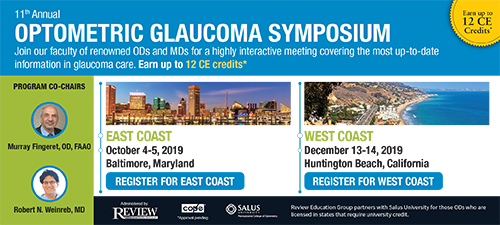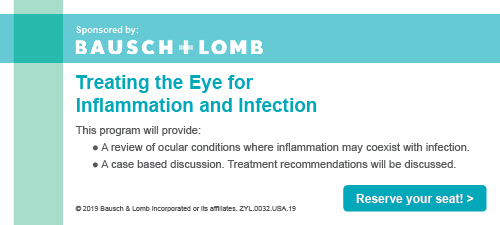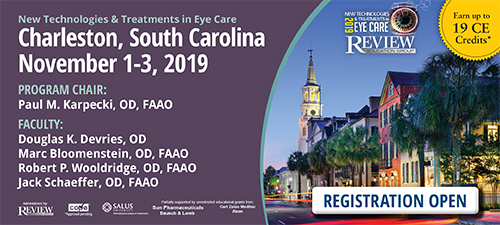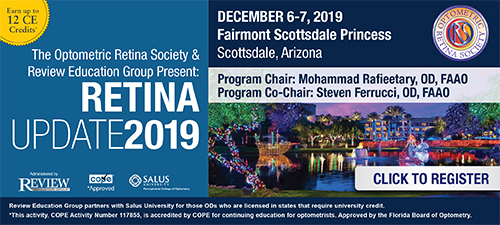
A
weekly e-journal by Art Epstein, OD, FAAO
Off the Cuff: Hubble…Is the End Finally in Sight for Rubble?
This week, I am proud to share this space with guest editor Dr. Sally Dillehay, now the chief medical officer of ClinTrialSolutions in Roswell, Ga. I’ve known Sally for many years, back to when she worked at Ciba Vision. I’ve long respected her as a quiet, but intense giant within the contact lens community and our profession. Below, she shares her part in a story that appeared in The New York Times earlier this week, providing valuable background about how Hubble built a business by gaming and abusing the FTC's dysfunctional passive verification system. Hubble became darlings of a blindsided venture capital community and Colgate-Palmolive by making a laughing stock of the FTC and FDA, and by putting patients in harm’s way. Thanks to Sally for sharing this. Here’s Sally: I was recently interviewed by The New York Times about Hubble Contact Lenses because its founders contacted me late in 2015, before they even were in business. As they detailed their business plan to sell “consumers” their brand of contact lenses without an actual prescription and only involve a doctor if they absolutely “had to,” I listened with great concern. I explained that the Fairness to Contact Lenses Consumer Act (FCLCA) does not permit them to create a new prescription, only to request verification from a patient’s doctor that a valid prescription exists for a specific contact lens for that patient. I explained that there was no such thing as a generic contact lens brand, nor did the FCLCA permit different brand substitution, except in very specific circumstances (same lens, material, manufacturer, and parameters).Recently, Hubble began sending verification requests to me, for people whom I have never met, to a location I have not been at for more than 18 months and from which I have never written prescriptions. I emailed and called them, reporting that I had never met these people and demanded that they stop selling contact lenses without a valid existing prescription using my name and license number to do so. The requests continued. I filed multiple complaints with the FDA, FTC and AOA, and included this information from an AOA document: “Can a contact lens seller sell a contact lens without having any prescription? NO! There are serious penalties of up to $11,000 per violation for a contact lens seller violating any provisions of the FCLCA.” When I spoke to colleagues about my recent experience, many of them shrugged their shoulders and said, “Yeah, we get those all the time.” Requests to “verify” a prescription for someone whom you have never met are different. According to Craig Steinberg, OD, JD, this may have legal implication as “you may get dragged into something you should not have gotten dragged into. This is, in essence, a form of identity theft. You are the victim of a fraud as your identity has been stolen and used illegally. Do you have any actual liability if the person has an issue with the lenses? No. Of course not. However, you may have to prove that, and that may mean time and expense—much like the victim of any number of identity theft fraud schemes. Sadly, there is little any of us can do ourselves to prevent this abusive and fraudulent behavior. Only aggressive action by governmental regulators, including the FTC, FDA, and state and federal attorneys general can stop it.” I would like to encourage you all to report each of these non-valid prescription verification attempts. When you respond to each request, write across it: “DENIED: NO VALID PRESCRIPTION EXISTS.” Log the patient name, address, date and time of the call, and indicate if the person is not a patient in your practice or has never been evaluated for the lenses. Once a month, file the list with a complaint to the FDA, FTC, AOA, and Hubble’s “doctor verification” email. Perhaps the sheer volume will finally get the FTC to put a stop to this blatant exploitation of “passive verification” when no valid prescription even exists. Sally M. Dillehay, OD, EdD, FAAO
|
|||||
 |
||
| Quantification of Accommodative Response and Visual Performance in Non-presbyopes Wearing Low-add Contact Lenses | ||||
Digital eye strain encompasses a range of ocular and visual symptoms across all age groups. Recently, symptoms associated with accommodative or binocular vision stress have become a major problem, especially in young individuals. The purpose of this prospective, single-blinded study was to objectively quantify the accommodative response and visual performance of low-add soft contact lenses (CLs) in young non-presbyopic individuals. A daily disposable low-add bifocal design lens (low-add CL) was tested. It employs a center-distance optical zone and peripheral zone with the added power of +0.50D to support near vision. Sixteen subjects ages 20 to 39 years were enrolled in the study. Refractive state and accommodation were measured using an open-field autorefractor with three target vergences, namely, -0.20D, -2.5D and -4.0D. Binocular visual acuity at high (100%) and low (40%, 20%) contrast and reading ability were assessed. Monofocal soft CLs were used as controls.
Accommodative response with low-add CLs was significantly smaller than those with two monofocal CL wearing conditions, i.e., at 40cm (2.5D of stimulus) and 25cm (4D of stimulus). The 20% contrast visual acuity at distance was significantly better with low-add CLs and second-time monofocal CLs compared with first-time monofocal CLs. The reading ability was not significantly different. Quantification of accommodative response and visual performance demonstrated that using low-add CLs alleviated the accommodation under the near-vision condition, without sacrificing distance vision, in non-presbyopes. |
||||
SOURCE: Koh S, Inoue R, Sato S, et al. Quantification of accommodative response and visual performance in non-presbyopes wearing low-add contact lenses. Cont Lens Anterior Eye. 2019; Jul 19. [Epub ahead of print]. |
||||
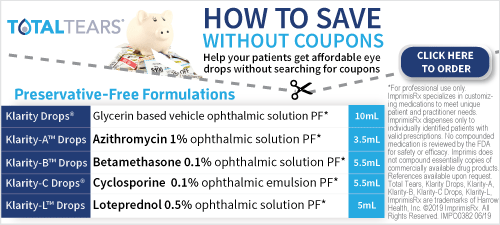 |
||
| Evaluating a New Objective Grading Software for Conjunctival Hyperemia | ||||
Standardized numeric grading scales are used in ophthalmic practice to improve consistency between clinicians in recording the severity of ocular conditions and to facilitate the monitoring of such changes. Researchers investigated the intra- and inter-observer grading reliability and the agreement between subjective Cornea and Contact Lens Research Unit (CCLRU) and Efron grading scales, as well as a new Advanced Ophthalmic Systems (AOS) software that uses an objective approach to grading conjunctival hyperemia. One experienced observer graded n=30 bulbar and n=26 palpebral conjunctival hyperaemia images to 0.1 increments. Masked grading of randomized images was undertaken for all three methods on two separate occasions. The agreement within and between the grading methods was assessed between sessions, and compared to the results of a novice observer.
There were no statistically significant differences between test and retest values. However, repeatability in the grading estimates of both bulbar and palpebral conjunctival hyperemia was improved using the AOS grading method (R2=0.998; Coefficient of Repeatability CoR 0.10 to 0.13), compared with Efron (R2=0.926; CoR 0.62) and CCLRU (R2=0.885 to 0.911; CoR 0.50 to 0.78). Intraclass coefficient correlations (ICC) improved inter-observer agreement using objective (>0.995) vs. subjective methods (0.853 to 0.959). These subjective and objective grading methods were not interchangeable. Researchers wrote that, due to the excellent repeatability and improved agreement between experienced and novice observers, the objective grading method provided a more consistent approach when grading ocular abnormalities and might achieve greater reliability in record keeping and clinical monitoring in the future. |
||||
SOURCE: Huntjens B, Basi M, Nagra M. Evaluating a new objective grading software for conjunctival hyperaemia. Cont Lens Anterior Eye. 2019; Jul 17. [Epub ahead of print]. |
||||
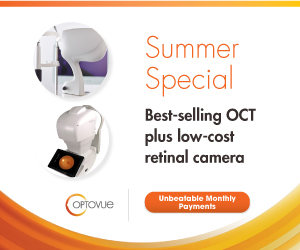 |
||
| Viral Conjunctivitis: A Retrospective Study in an Australian Hospital | ||||
This retrospective, single-center case series was conducted to update the literature on the current trends of viral conjunctivitis infections in Sydney, Australia, to find correlations between viral and patient characteristics on disease outcomes, and to assess the rates of antibiotic and steroid use in patients with viral conjunctivitis prior to and after assessment by ophthalmology trainees. A total of 368 eyes of 224 patients diagnosed with viral conjunctivitis at the Sydney Eye Hospital from Jan. 1 to March 31, 2017, were identified from hospital records or polymerase chain reaction results and included in the study. The median patient age was 35.3 (range, 7 to 82) and 59.8% males. A total of 152 (67.9%) patients presented already on antibiotic treatment. Most (83.5%) had no previous ocular history aside from 35 (15.6%) who were regular contact lens wearers. PCR was performed in 170 (75.9%) patients, with 92 (54.1%) positive for adenovirus, and seven (4.1%) positive for HSV. The average duration of symptoms prior to presentation was 6.3 days. A total of 177 (78%) patients presented within one week of symptom onset, and these patients were more likely to be adenovirus positive on PCR (OR=2.37). Patients with symptoms of longer duration were more likely to have photophobia (OR=2.96) and have had steroid treatment (OR=3.80). Patients with viral conjunctivitis typically presented within a week of symptoms onset, with bilateral disease and on topical antibiotics. Pseudomembranes and a palpable preauricular lymph node were not common. Investigators suggested that, as treatments emerge for viral conjunctivitis, patients should be encouraged to present earlier. |
||||
SOURCE: Marinos E, Cabrera-Aguas M, Watson SL. Viral conjunctivitis: a retrospective study in an Australian hospital. Cont Lens Anterior Eye. 2019; Jul 9. [Epub ahead of print]. |
||||
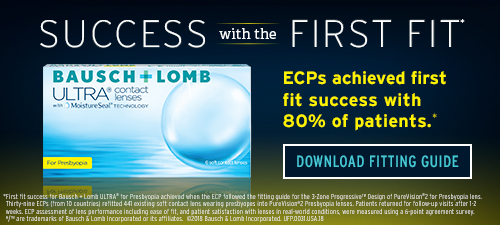 |
||
| News & Notes | |||||||||||||||
| Academy Announces 2019 Award Recipients The 2019 American Academy of Optometry award winners will be recognized at the Joint American Academy of Optometry and World Council of Optometry Recognition Gala and Awards Program Oct. 26 at the Hyatt Regency Orlando. The Fry and Prentice Lectures, to be held Oct. 25, will feature lectures from the Charles F. Prentice Award recipient and the Glenn A. Fry Award recipient. The section on Cornea, Contact Lenses and Refractive Technologies award recipients will be honored Oct. 23, and the Public Health and Environmental Vision Section Henry B. Peters Awardee will be honored Oct. 24. The joint meeting of the American Academy of Optometry and World Council of Optometry, Academy 2019 Orlando and 3rd World Congress of Optometry, will take place Oct. 23-27 at the Orange County Convention Center in Orlando, Fla. View the 2019 award recipients.
|
|||||||||||||||
| Allegro to Present Results of Phase II Risuteganib Intermediate Dry AMD Study Allegro Ophthalmics announced that the results of its Phase II study evaluating risuteganib (Luminate) for the treatment of intermediate nonexudative age-related macular degeneration would be presented during the American Society of Retina Specialists Annual Meeting (July 26-30) in Chicago. In June, Allegro announced topline results of the Phase II intermediate dry AMD clinical trial, which met its primary endpoint with 48 percent of individuals in the risuteganib arm at week 28 gaining ≥8 letters from baseline, compared with 7 percent of individuals in the sham group at week 12 (p=0.013). Read more.
|
|||||||||||||||
|
|||||||||||||||
|
|||||||||||||||
|
Optometric Physician™ (OP) newsletter is owned and published by Dr. Arthur Epstein. It is distributed by the Review Group, a Division of Jobson Medical Information LLC (JMI), 11 Campus Boulevard, Newtown Square, PA 19073. HOW TO ADVERTISE |



